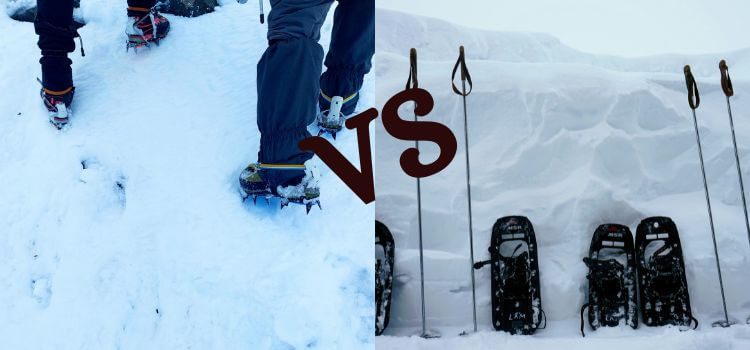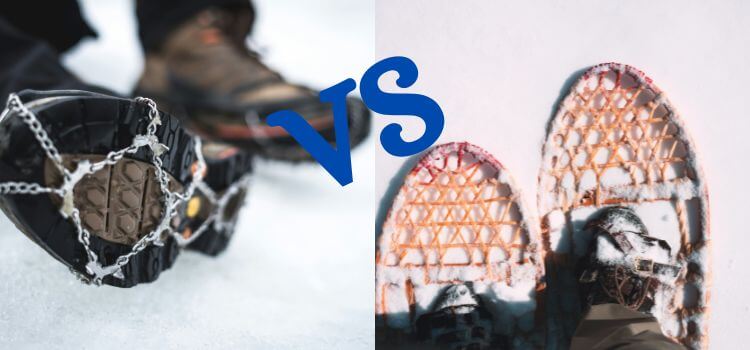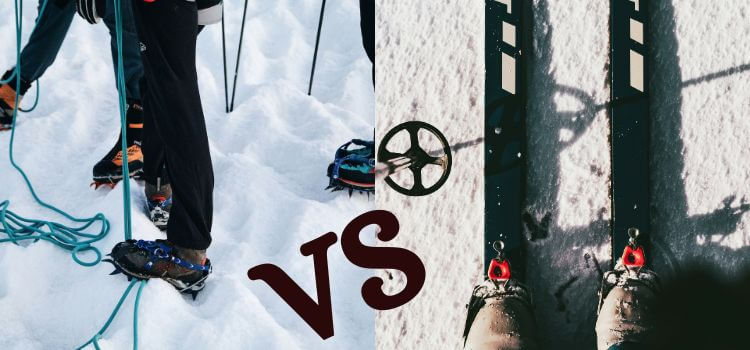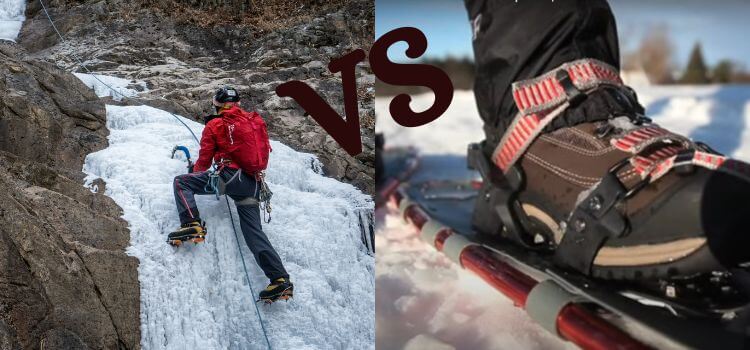Snowshoes and crampons serve different purposes for winter traction. Snowshoes distribute weight over a larger area to prevent sinking, while crampons aggressively grip ice.
Choosing the right gear for winter excursions is crucial for safety and mobility. Snowshoes and crampons are essential, but they cater to different terrain challenges. Whether you’re crossing a snowy path or scaling an icy incline, understanding the functionality of each can optimize your outdoor adventure.
Snowshoes excel in deep Snow, where their broad surface area prevents you from sinking, making them ideal for hiking and exploration. They enable stable footing and ease of movement in powdery landscapes.

On the flip side, crampons boast sharp metal spikes offering a steadfast grip on solid ice and steep slopes, essential for activities like ice climbing or glacier traversing. When navigating the wintery outdoors, selecting between the floatation of snowshoes and the precise bite of crampons can transform your experience from a struggle to a stride.
Introduction To Winter Traction
Navigating through Snow and ice presents unique challenges. Proper traction ensures safety and mobility in winter terrains. Depending on activity and terrain, They select the right gear, whether snowshoes or crampons. Knowing the differences and uses helps adventurers choose effectively. This article compares snowshoes and crampons, addressing the importance of footing and giving a brief overview of each traction device.
Importance Of Proper Footing In Snow And Ice
Winter landscapes can be unpredictable. Safety hinges on the stable footing to prevent slips and falls. Correct use of traction aids can mean the difference between an exhilarating experience and a dangerous one.
Brief Primer On Snow Shoes And Crampons
Snowshoes distribute weight over a larger area. This prevents sinking into soft, deep Snow. Snowshoes are ideal for hiking snowy trails. On the other hand, crampons are metal spikes that attach to footwear. Crampons bite into ice and hardpack, offering superior grip on steep or icy terrain.
To grasp their benefits and intended use, let’s compare them in detail:
Table Comparison
| Snowshoes | Crampons |
| Designed for deep Snow | Best for ice and hard Snow |
| Widen footprint to prevent sinking | Sharp points for maximum grip |
| Suitable for flat to rolling terrain | Preferred for steep inclines |
| Feature bindings to fit various boots | Require compatible boots for attachment |
The choice depends on the terrain and the type of hike planned. Understanding the unique features of snowshoes and crampons empowers wintertime explorers to select the best equipment for their adventures.
Snow Shoes: A Comprehensive Guide
Exploring snowy landscapes needs the right gear. Snowshoes are crucial for such adventures. They help you walk on Snow without sinking. Let’s dive deep into their world.

Design And Functionality
Snowshoes spread your weight over a large area. They do so because of their unique design. This prevents you from sinking into the Snow. They have a frame and webbing or a solid deck. The bindings attach to your boots.
- Frames are usually aluminum or plastic.
- Decking made of synthetic fabrics.
- Bindings can be flexible or rigid.
- Metal teeth on the bottom help with grip.
Ideal Conditions For Use
Snowshoes are best in deep, powdery Snow. They are great for hiking or casual walking. Their design helps them stay on top of the Snow. This makes movement easier in these conditions. Use them in snowy forests or open fields.
| Condition | Suitability |
| Deep Snow | Highly Suitable |
| Powdery Snow | Highly Suitable |
| Packed Snow | Moderate |
| Icy Terrain | Not Suitable |
Pros And Cons
Snowshoes offer a mix of advantages and drawbacks.
Pros:
- Allow hiking in deep Snow.
- Easy to learn and use.
- No technical skills needed.
- It’s cheaper than other gear.
- Good for fitness.
Cons:
- Not ideal for icy or steep terrain.
- It can be bulky to transport.
- Slower than skis on packed trails.
Crampons: The Technical Details
Welcome to the peak of precision and performance in snowy terrains: crampons. Here, we’ll delve into the nitty-gritty of these vital mountaineering tools. Understanding their construction, suitable environments, and pros and cons is essential for adventurers. Let’s explore the technical aspects of crampons.

Construction And Materials
Crampons are engineered for durability and grip. They consist of a frame with spikes, usually referred to as points. The materials most commonly involved include:
- Steel: Ideal for icy and rock-abrasive conditions.
- Aluminum: Lighter but less durable than steel, perfect for snowier routes.
- Stainless steel: Combines rust resistance with ruggedness.
Advancements in technology have introduced hybrid models, blending both materials to strike a balance between weight and resilience.
Preferred Terrain And Circumstances For Crampons
These devices shine in specific settings. Their design suits them ideally for:
- Ice climbing
- Glacier travel
- Steep snowfields
- Mountaineering
With the proper technique, crampons provide stability and security, preventing dangerous slips and falls in treacherous icy terrains.
Advantages And Disadvantages
| Advantages | Disadvantages |
| Enhanced traction on ice/Snow | Heavier than other traction aids |
| Versatile for varying ice conditions | Requires skill to use safely |
| Durable construction | May not be needed on less steep terrain |
While the benefits are clear, crampons demand respect and proper usage. Knowing when and how to use them is crucial to maximize their effectiveness while ensuring the safety of the adventure seeker.
In-depth Comparison
The right gear on your feet can transform a tricky winter trek into a thrilling adventure. Snowshoes and crampons serve different, vital roles in your encounters with slippery, frosty terrains. Let’s dig deep into their features, examining them side by side for a clear view of their utilities and uniqueness.
Traction Mechanisms Explored
Snowshoes have a broad base, distributing your weight evenly over a large area, preventing sinking into the Snow. Their frames, often made of lightweight aluminum or plastic, are surrounded by webbing or synthetic decking. Firm grips are provided by crampon-like teeth situated at the base, known as cleats.
Crampons, on the other hand, boast metal spikes varying in number and length. These spikes dig into ice or hard Snow, securing a hold that prevents slipping. The front points allow for toe kicking into steep ice, essential for ice climbing or treacherous slopes.
Comparative Stability On Various Surfaces
When faced with deep, soft Snow, snow shoes shine, creating a stable platform that hinders sinking, icy inclines, and technical climbs call for crampons, which bite into the hard surface for unshakeable footing.
| Snow Shoes | Crampons | |
| Deep Snow | Excellent stability | Less effective |
| Icy Slopes | Challenging to use | Superior grip and stability |
Weight And Mobility Considerations
Snowshoes tend to be lighter, aiding in prolonged treks without adding much fatigue. They are bulkier, though, which may hinder maneuverability in tight spots.

Crampons, being compact, add negligible weight and bulk to your feet, allowing for precise and agile movements, especially on steep or technical terrain.
- Snow Shoes: Lightweight yet bulky, less fatigued over distances.
- Crampons: Compact and light, precise movements on challenging terrain.
User Experiences And Recommendations
The proper footgear is crucial when braving winter landscapes. In the snow shoes vs. crampons debate, user experiences can illuminate which is best for your cold-weather adventures. Let’s delve into real-world insights and tailored advice from the winter sports community.
First-hand Accounts From The Winter Sports Community
Outdoor enthusiasts often share their experiences with gear. Here’s what they say:
- Snowshoes excel on fresh powder.
- Crampons are ideal for icy inclines.
- Some prefer hybrid designs for flexibility.
Situational Recommendations For Snow Shoes And Crampons
Choosing the right gear depends on specific conditions:
| Terrain | Snow Shoes | Crampons |
| Deep Snow | Best Choice | Not Suitable |
| Icy Surfaces | Not Ideal | Best Choice |
| Mixed Terrain | Good | Good |
Adapting To Activities: Hiking, Climbing, And Trail Running
Different activities require extra gear. Consider the following:
- Hiking: Snowshoes for deep Snow, crampons for icy paths.
- Climbing: Crampons offer better grip on steep ice.
- Trail Running: Lightweight crampons ensure agility.
Safety First: Best Practices
Exploring snowy landscapes demands the right gear. Both snowshoes and crampons play crucial roles. Yet, safety always comes first. This section highlights how to use these tools safely and keep them in top condition.
Proper Usage And Technique
Correctly using snowshoes and crampons is vital. Let’s break down the essentials:
- Snowshoes: Spread weight evenly. Prevent sinking into Snow.
- Crampons: Provide grip on ice. Practice walking before actual use.
Learn the basics in a controlled environment. Join a class or seek guidance from a professional.
Maintenance And Care For Longevity
Take care of your gear correctly. Durable snowshoes and crampons last longer. Adhere to these tips:
- After each use, clean off Snow and ice.
- Dry thoroughly before storage.
- Inspect for damage. Repair if needed.
Proper maintenance extends the life of your equipment. It ensures reliability on your next adventure.
Essential Safety Tips For Winter Terrain
Navigating winter terrain can be tricky. Always prepare. Follow these safety tips:
| Snowshoes | Crampons |
| Choose based on weight and terrain. | Match crampon points to activity. |
| Avoid deep Snow on slopes. | Attach securely to boots. |
| Carry poles for balance. | Beware of balling underfoot. |
Always check weather conditions. Tell someone your route. Be prepared for emergencies.
Frequently Asked Questions On Write A Comparison Article On Snow Shoes Vs Crampons.
What Is The Difference Between Snowshoes And Crampons?
Snowshoes distribute weight over a larger area to prevent sinking in Snow, while crampons provide grip on ice with metal spikes. Snowshoes are best for deep snow travel, and crampons are designed for icy terrain.
What Is The Difference Between Crampons And Cleats?
Crampons are metal spikes for climbing and hiking on ice or Snow. Cleats are small, protruding elements on shoes for grip on soft surfaces like dirt or grass.
What Is The Difference Between Snowshoes And Snow Boots?
Snowshoes are designed for walking on Snow with a wide, flat surface to distribute weight, whereas snow boots are insulated footwear meant to keep feet warm and dry. Snowshoes prevent sinking, while snow boots protect against cold and moisture.
Are Crampons Good For Snow?
Crampons are highly effective for navigating snowy terrain. Their spiked design improves traction, making them essential for secure movement on Snow and ice.
Conclusion
Deciding between snowshoes and crampons depends on your adventure. Snowshoes excel in deep Snow, providing flotation. Crampons offer precise traction on ice. Both serve unique purposes in winter landscapes. Choose wisely for safety and enjoyment on your chilly excursions. Your winter expeditions deserve the right gear.
Related posts:
- Volleyball Vs. Tennis Shoes
- Canvas Vs. Leather Ballet Shoes
- Indoor Vs. Outdoor Soccer Shoes
- Baseball Cleats Vs. Softball Cleats
- Neutral Vs. Stability Running Shoes
- On Cloud Vs. Nike
- Brooks Running Shoes Vs. Hoka
- Crocs Baya Vs. Classic Differences
- Baseball Shoes Vs Football Shoes: Ultimate Performance Guide
- Volleyball Shoes Vs Sneakers: The Ultimate Performance Showdown
